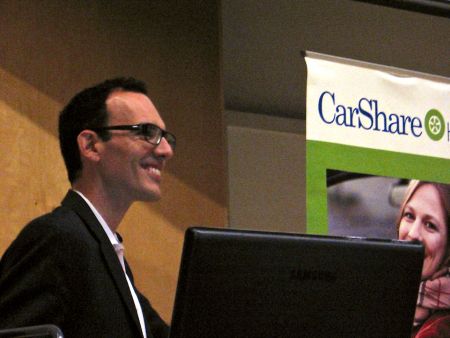HALIFAX — It’s West Coast; we’re East Coast. It was 14 degrees Friday; we clocked in at -14. But Tim Papandreou thinks Halifax’s transportation system can learn a thing or two from San Francisco.
The transit expert presented the details of San Francisco’s ongoing transportation revolution to a near-full Dalhousie University auditorium Friday. The event was the tail-end of a trip that saw Papandreou spread his transit gospel to several Halifax government agencies and other organizations, including HRM’s transportation committee.
The city-county of San Francisco has over 800,000 people living in 121 square kilometres. It is surrounded by water on all three sides and is mainly accessible by bridges. It has a weakening infrastructure, aging population and declining job centre.
“Sound familiar?” Papandreou asked the audience.
The similarities don’t stop there. Prior to the year 2000, conflicting and competing service providers, poor funding, and a lack of business and public support plagued San Francisco’s transportation network. The system was in shambles.
Not anymore.
As the Deputy Director of Sustainable Streets in San Francisco, Papandreou is helping to rejuvenate the city’s transportation system by focusing on a multi-modal model and partnership approach.
Even though “the devil’s in the details,” this two-hit strategy is deceivingly simple on its surface.
The city began by integrating as many of its transportation services as possible. By 2009, the Department of Traffic, the Taxi Commission, public transit operations and municipal-led services like walkways all fell under one organization: the San Francisco Municipal Transportation Agency.
This amalgamation meant combining costs and revenues. “We take the money from parking and parking fines,” said Papandreou, “and move that over to transit.”
It also entailed integrating the governance of transportation services, the future of which is now being dictated by a 2013-2018 strategic plan. Unlike Metro Transit’s half-unfinished, more-of-a-dream-than-an-achievable-reality strategic plan, which is set to expire this year, San Francisco’s is founded on small, step-by-step, attainable goals. Every staff person is in charge of one part of these steps, and annual review of the strategy will ensure they are on track.
At the heart of this plan is the multi-modal model. “There’s no one mode that fits everyone’s needs,” said Papandreou, “People by definition are multi-modal and [we are] really moving away from a discussion of ‘I’m a pedestrian,’ ‘I’m a cyclist,’ ‘I’m a motorist,’ and moving toward ‘I’m a citizen.’”
This mantra means improving all transportation options for the sake of making a better city, said Papandreou. The past emphasis on better conditions for drivers has, in turn, deteriorated the road conditions for pedestrians, cyclists and public transit users, making more people turn to cars, and perpetuating a vicious cycle bent on automobiles, he said.
The city did a cost-benefit analysis of the main modes of transportation and found cars to be the most cost-heavy, while biking and busing are the most balanced.
“Every dollar you invest in driving, you’re wasting a lot of money,” said Papandreou.
So, part of the five-year strategic plan is to achieve a 50-50 split between car and non-auto transportation. The city also wants to see a 15 to 20 per cent reduction in the number of cars in the city by 2030.
San Francisco is slowly updating the infrastructure of its roadways to the “complete streets” model, with space for every mode: pedestrian walkways; and car, bus and bike lanes. It has also been analyzing traffic at intersections to determine improvements that could benefit all travellers, closing streets for pedestrian enjoyment, and surveying cyclists to see how they use the roads.
Small changes like developing a free parking spot-locator smartphone app and opening all doors of a bus to keep public transit schedules on time help improve the city’s transportation network while money is being collected for larger projects.
Key to accomplishing these bigger targets is getting the public on board and keeping it informed every step of the way, said Papandreou.
The transportation agency has been partnering with developers to meet land-use expectations for transit. New developments are now required to include a few car-sharing-only parking spots, and condominium managers are encouraged to include transit passes in the fees for their buildings.
The agency has also approached local businesses to show their owners that walking — not parking — is good for economic development, and that “bikers are consumers just like people in cars,” said Papandreou.
“These discussions are not possible without multiple stakeholders,” Papandreou said of the strategic plan’s many layers. “Conversations are really cheap; they’re virtually free. And fixing mistakes are very expensive.”
More than offering examples of success, Papandreou had some words of encouragement for Halifax Friday: “You have great bones in place; you just need to [rewrite] your purpose statement … and you don’t need to reinvent the wheel,” he laughed, “We’ve made a lot of mistakes for you.”



